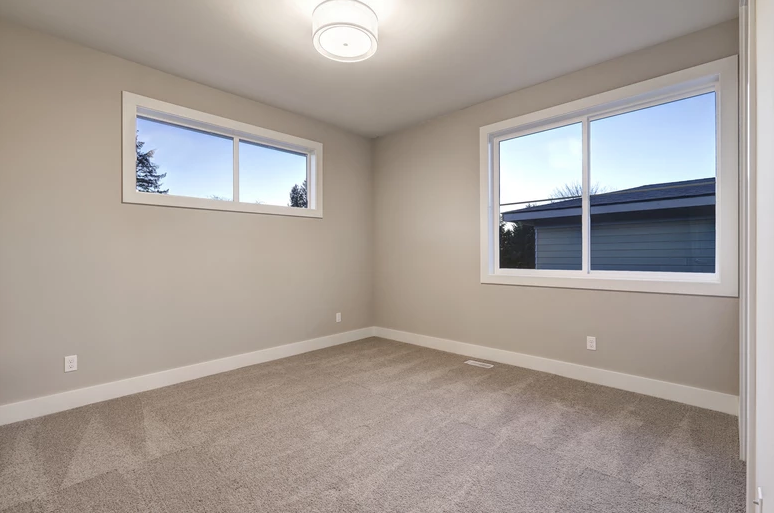One of the easiest things to do for a homeowner to increase the look and feel of their home is painting a room. Most anyone can do this without my advice but here are some simple steps to make things look like a professional completed the job.

How to Paint a Room (Like a Pro)!
One of the easiest things to do for a homeowner to increase the look and feel of their home is painting a room. Most anyone can do this without my advice but here are some simple steps to make things look like a professional completed the job.
Tools/Materials Needed:
- Painters putty
- Acrylic latex caulking / caulking gun
- Quality paint brush
- Roller frame and extension pole
- Quality roller nap suited for job (more on this later)
- 5 gallon bucket
- 5 gallon bucket grid
- Drop cloth
- 1.5" blue tape
- Putty knife
These are the basic tools and materials needed to make the job go as smoothly as possible. Remember not to be cheap when purchasing paint brushes and roller naps, these definitely make a difference! A quality brush (purdy, wooster) will run you around $12/$15 at Home Depot or Lowes.
Order of Operations:
Don't worry, we aren't talking about math here. The order in which you paint can vary dramatically depending on the job and or professional completing the project. I'm going to guess that if you're reading this you are not a professional and this procedure is catered towards the DIY guy or gal to keep things simple for them.
- Prep the surfaces to be painted and protect flooring.
- Prime the surfaces that need it. (Clarification on this later)
- Putty nail holes.
- Caulk cracks & gaps.
- Paint ceiling first to protect walls from roller splatter.
- Paint walls to protect trim from roller splatter.
- Paint trim last (easiest for the DIY'er).
Prep:
Fill in any small wall imperfections with shrink free spackling. Before doing this, it is best to take the back of your putty knife and press in any imperfection. This will give the spackle a better surface to fill in case there is any raised drywall paper (fuzz). An easy way to spot these small imperfections is to use a bright handheld light to shine along the walls.
This is a good time to remove all light switch and electrical outlet covers. This will help in making things look like a professional did the job. They are usually only held on with one or two screws making this a very quick and easy task. It will save a lot of time when it comes to rolling the walls. You won't need to slow down and use a brush to cut in around sockets. After removing the covers take your 1.5" masking tape and tear off a piece to put over the sockets and switches to protect them.
You will want to use canvas drop cloths to protect the floor from paint drips, splatter and potential bucket tip overs. These drop cloths come in many different sizes and I would advise getting the ones with plastic backing. This will ensure that no paint can leak through. If the room you are painting is carpet you can usually take your tape and tape down the edge of the drop cloth right up against the trim and use your putty knife to push the tape under the trim and this will prevent any paint from getting onto the carpet around the edges of the trim. If you are painting on hardwood or tile floors then you will want to tape a straight light right up to your trim.
Prime:
We will not need to prime the walls since they are already painted. There are a few exceptions to this; walls that have stains, previously painted with oil based paint, have large drywall patches or you are painting a dark vivid color. In any of these cases it would be best to prime the room with a stain blocking primer. A particular favorite of mine is Zinnser shellac based primer and sealer. This will be the same product you will use on your trim if it was previously painted with oil based paint. You can refer back to my blog about painting trim and doors to see why I urge the DIY'er to use latex based paint. A good way to determine what kind of paint you are working with is to take denatured alcohol on a rag and rub the paint. If the paint comes off it is latex, if not, it's oil based.
PUTTY / CAULK:
Filling nail holes with putty or spackling comes before caulking so you do not muck up your caulking job. You can use the shrink free spackling that you used for the walls to fill nail holes in the trim. Even though it say's shrink free on the container it will most likely shrink leaving a small divot after sanding. This is fine just apply another coat and sand smooth. I prefer to use Crawford's Putty for nail holes because it does not shrink hence no need for second application or sanding and it dries very hard.
You will want to use acrylic latex caulking to fill in any gaps between trim and drywall. Check around baseboards, window sills and door frames for any cracks or gaps to fill. You can also use this in all the 90 degree drywall joints to make the drywall lines more crisp and uniform in appearance. You will want to cut your caulking tube tip at a 45 degree angle using a razor knife or utility knife. Puncture the seal of the tube with the metal punch on the side of the caulking gun or a nail if yours does not have one. You want to hold the caulking gun at the 45 degree angle you cut the tip so that the opening is parallel to the the surface. Always start by cutting the tip small and work your way up cutting it larger if you need to fill a bigger gap. You want apply a smooth, even bead while avoiding much excess. Use a wet finger to smooth the bead before it starts to dry. I like to use a tile sponge and a gallon bucket filled with water but a wet rag will work. Use a mold and mildew resistant caulking when working in kitchens and bathrooms. 100% silicone caulking is only used on surfaces that will not be painted.
PAINT:
Begin by mixing your gallons of paint into a 5 gallon bucket. Typically 1 gallon will cover 250-450 sq ft of surface depending on how thick the texture, quality of the paint and your color choice.
Do not use a roller tray! This is a recipe for disaster not to mention inefficient, a mess to deal with and nevermind just DON'T USE IT. When mixing your gallons in a 5 gallon bucket you will first ensure that your paint is going to be even and no variances will be seen between gallons. This is not usually an issue these days with paint mixing technology, but it's better to be safe and save yourself some time by boxing out your individual gallons in a 5 gallon bucket. The next advantage of the 5 gallon bucket is you won't have to keep pouring paint into a flimsy paint tray every 3 passes of a roller. The biggest advantage is the cleanliness of the 5 gallon bucket compared to a tray. You won't step in a bucket but I guarantee you will find a way to step in a tray. You will take your 5 gallon bucket grid and hang it on the edge of the bucket with the grid inside the bucket. This will be what you use to remove the excess paint off of the roller before carrying it to the surface to be painted. This is way more efficient than a rolling tray (I hate rolling trays if you haven't noticed).
Steps:
Use a brush to paint around edges and around light fixtures.
Dip roller in bucket and use grid / screen to remove excess.
Start in a corner and work your way from one side of the room to the other keeping a wet edge. You will want to move at a decent speed but not to fast so that you prevent paint splatters. Every 3 to 5 feet you will want to back roll the area just completed going in one directional passes. This will spread and even out the paint as well as prevent that vacuumed carpet look (flashing) you sometimes get when rolling ceilings and walls.
Dip the roller again keep going in this fashion until the entire ceiling is painted making sure to back roll ever so often to smooth out lines.
Pour remaining paint back into 1 gallon bucket and clean your brush and roller.
Allow the ceilings to dry overnight. You will want to increase the heat if possible and the more air flow the better. This is where fans come in handy.
The walls will be done in the exact same fashion but I'm assuming you are going a different color as most people do so you will need to pull out your (cut in skills) to do this.
First you will brush up to the ceiling on one wall doing your best to create a straight line and not to muck up those pretty ceilings. If you do get some on the ceiling don't freak out it can always be touched up after it drys. I think this will be my next blog post (Cutting in like a PRO).
You will want to roll the wall you just cut in with a brush so that the paint is still wet preventing flashing. Make sure to brush down onto the trim also so that you are able to create a straight line later when painting the trim.
Continue your next 3 walls just like the first one you completed.
Allow this paint to dry overnight with increased heat and fans if possible just like the ceilings.
This is where you will use the 1.5" masking tape to mask off the walls all the way around the trim. Try to use long pieces by using the roll as a guide against the wall and trim. This will make it easier to pull and create straighter lines.
Starting in one corner we are going to do one wall at a time. Take your caulking gun and run a light bead of caulking where the tape meets the trim then wipe as much excess off as possible. This will create a barrier for the tape and prevent the paint from getting behind it. Trust me this is a lot easier to teach than cutting in perfectly straight lines, and way faster. After you paint one wall pull the tape while the paint is still wet to prevent sheering of the paint. (This probably needs to be another blog post)
Continue the next 3 walls the exact same way.
This can be done around door jambs and window sills also.
That's a wrap, now you just have to wait for the paint to dry thoroughly before installing light switch covers and outlet covers.
